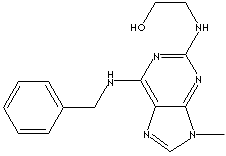| Purine is a heterocyclic compound featured by a fused pyrimidine and imidazole
rings composed of carbon and nitrogen atoms. The simplest one is purine itself
and the two major purines are adenine(6-Aminopurine) and
guanine(2-Amino-6-hydroxypurine) which are two bases components of nucleic acid
and the nucleotides. Purine itself is not found in nature, but as substituted
purines such as methyled, hydroxyl and amino substituted. In addition to adenine
and guanine, a group of chemical compounds called purine base include
hypoxanthine (6-oxypurine), xanthine (2,6-dioxypurine), uric acid
(2,6,8-trioxypurine), and theobromine (3,7-dimethyl xanthine). Theophylline and
caffeine are a member of methylated purine family. Purines are biologically
important in In medicine and biological research.
Olomoucine
is, a
purine derivative, is
a potent
and very selective inhibitor of cyclin-dependent kinases
(cdc2 and cdk2/cdk5) and induces G arrest.
|
